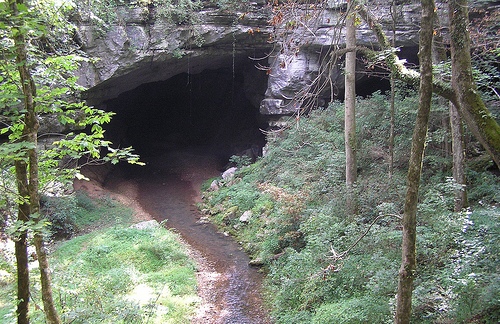

Location: Jackson County, Alabama Map
Area: 310 acres (130 ha)
Russell Cave National Monument is an important archaeological site of pre Columbian Native American cultures that once lived here. Russell Cave National Monument is located in Jackson County in Alabama and cover a total area of 310 acres (130 hectares). Archaeological digs in Russell Cave National Monument showed that people first settled in the area 10,000 years ago. Radiocarbon dating of charcoal left from fires Archaic people burned here were date as early as 6550- 6145 BC. This natural formation could house several families of 50- 60 people. The cave provided shelter from the natural elements as well as constant source of water that flows here.
The limestone surrounding Rusell Cave was formed
approximately 300 million years ago from the deposits of skeletons and
shells from a lake that existed at the time. Rainwater, slightly acidic
due to carbon dioxide absorbed from the air, dissolved part of the
limestone and created the cave. About 10,000 years ago part of the roof
collapsed near Doran's Cove. The resulting sinkhole revealed an entrance
to the cave.
For a long time, the cave was inaccessible due to
water currents, but another rockfall diverted the water currents in such
a way that part of the bottom became accessible. Further ceiling
collapses lifted the entire floor of the cave more than 2 meters, and
even 9 meters near the entrance. In 1960, the cave was secured by
various measures to prevent further collapses.
The opening of the
cave faces east, so that cold north and north-west winds are kept out,
which favored settlement by animals and humans.
Historical biology and
paleobotany studies show that the fauna and flora of the Eastern
Forest Region have not really changed for thousands of years. This
situation begins to evolve as European settlers clear their land for
wood or for commercial and subsistence farming.
Russell Cave
is inhabited by bats and the cave's watercourse is home to a species
of fish (the "sculpin"). Different species of snakes live around the
cave, such as agkistrodon contortrix, crotalus horridus, elaphe and
king snake. More than 115 bird species have been identified by
researchers at Russell Cave or around it.
early history
Finds of broken fragments of
flint and charcoal show that the cave has been used by humans for
over 9000 years. The age of the finds was determined by radiocarbon
dating[6]. Due to the access protected from the weather, the cave
offered an ideal place of refuge, especially in autumn and winter,
especially since the lack of frost inside the cave meant that water
was always available from the river flowing through it. The
surrounding mixed forest offered extensive food resources such as
gray squirrels, raccoons, rabbits, gray foxes and turkeys. But
larger mammals such as bears and deer were also food sources
according to bone finds. The forest also offered plenty of plant
food.
Archaeological investigations
Archaeologists have
found over 2 tons of artefacts to date, including charcoal, bones
both as food remains and tools such as fish hooks and pottery
shards. The remains of human bodies were also found, which were
buried only superficially and without any grave goods.
The
first relics were found in 1953 when an expedition by the Tennessee
Archaeological Society and the University of Tennessee at
Chattanooga began excavating the cave. The first excavations were
carried out to about three feet, the type and number of finds led to
three further excavations (1956 to 1958) by the Smithsonian
Institution together with the National Geographic Society. The
National Park Service conducted the last excavation to date in 1962,
examining up to 10 meters of underground.